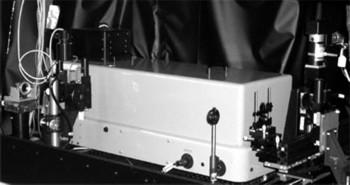Reference Transmittance Spectrophotometer (RTS)

The Reference Transmittance Spectrophotometer (RTS) is the national reference instrument for regular spectral transmittance measurements of non-fluorescent samples at room temperature. It is a custom-built instrument that uses a lamp-based, quasi-monochromatic system for illumination of the sample and broadband detection of transmitted radiation.
The illuminator consists two sources, a laser-driven light source (LDLS) and a quartz-tungsten-halogen (QTH) incandescent lamp, and a prism-grating monochromator. A sample carriage moves the sample in and out of the influx beam. The detection system consists of two detectors, a silicon (Si) photodiode and an extended indium-gallium-arsenic (InGaAs) photodiode. The combination of sources and detectors enable illumination and detection for wavelengths from the ultraviolet to the shortwave infrared.
We are currently implementing improvements to RTS including development of a new uncertainty budget.
Specifications/Capabilities
Conditions for transmittance measurements using RTS.
| Geometrical | |
|---|---|
| Illumination Angle | 0° |
| Viewing Angle | 0° |
| Sample Size | 10 mm to 50 mm |
| Sampling Aperture | 4 mm to 20 mm |
| Spectral | |
|---|---|
| Wavelength | 250 nm to 2500 nm |
| Bandwidth | 1.5 nm or 3 nm |
| Polarization | 0° to 90° |
| Measurand | |
|---|---|
| Quantity | Transmittance T |
| Technique | Absolute |
| Range | 0.001 to 1 |
| Uncertainty (k=2) | 0.1% to 0.5% |

